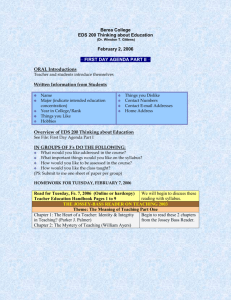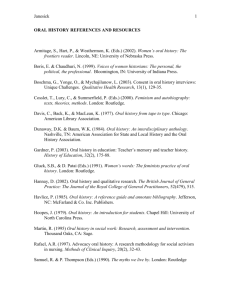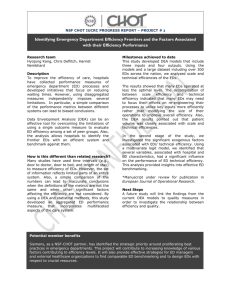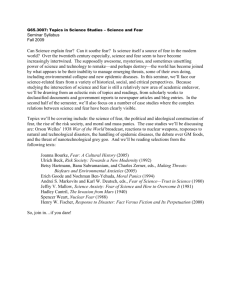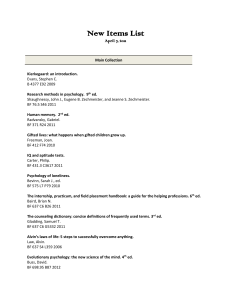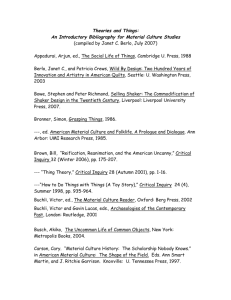Transfer of Learning
advertisement
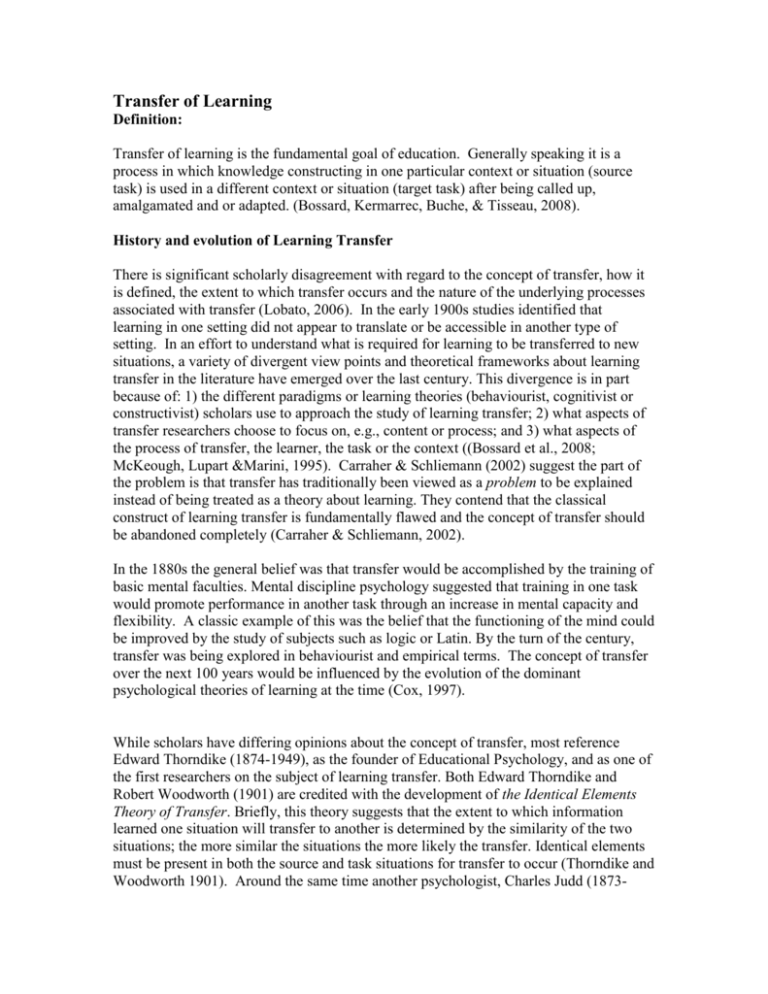
Transfer of Learning Definition: Transfer of learning is the fundamental goal of education. Generally speaking it is a process in which knowledge constructing in one particular context or situation (source task) is used in a different context or situation (target task) after being called up, amalgamated and or adapted. (Bossard, Kermarrec, Buche, & Tisseau, 2008). History and evolution of Learning Transfer There is significant scholarly disagreement with regard to the concept of transfer, how it is defined, the extent to which transfer occurs and the nature of the underlying processes associated with transfer (Lobato, 2006). In the early 1900s studies identified that learning in one setting did not appear to translate or be accessible in another type of setting. In an effort to understand what is required for learning to be transferred to new situations, a variety of divergent view points and theoretical frameworks about learning transfer in the literature have emerged over the last century. This divergence is in part because of: 1) the different paradigms or learning theories (behaviourist, cognitivist or constructivist) scholars use to approach the study of learning transfer; 2) what aspects of transfer researchers choose to focus on, e.g., content or process; and 3) what aspects of the process of transfer, the learner, the task or the context ((Bossard et al., 2008; McKeough, Lupart &Marini, 1995). Carraher & Schliemann (2002) suggest the part of the problem is that transfer has traditionally been viewed as a problem to be explained instead of being treated as a theory about learning. They contend that the classical construct of learning transfer is fundamentally flawed and the concept of transfer should be abandoned completely (Carraher & Schliemann, 2002). In the 1880s the general belief was that transfer would be accomplished by the training of basic mental faculties. Mental discipline psychology suggested that training in one task would promote performance in another task through an increase in mental capacity and flexibility. A classic example of this was the belief that the functioning of the mind could be improved by the study of subjects such as logic or Latin. By the turn of the century, transfer was being explored in behaviourist and empirical terms. The concept of transfer over the next 100 years would be influenced by the evolution of the dominant psychological theories of learning at the time (Cox, 1997). While scholars have differing opinions about the concept of transfer, most reference Edward Thorndike (1874-1949), as the founder of Educational Psychology, and as one of the first researchers on the subject of learning transfer. Both Edward Thorndike and Robert Woodworth (1901) are credited with the development of the Identical Elements Theory of Transfer. Briefly, this theory suggests that the extent to which information learned one situation will transfer to another is determined by the similarity of the two situations; the more similar the situations the more likely the transfer. Identical elements must be present in both the source and task situations for transfer to occur (Thorndike and Woodworth 1901). Around the same time another psychologist, Charles Judd (1873- 1946), argued that the identical elements theory was too simplistic and that transfer depended on how instruction was carried out. If the instructor taught for transfer and the learner discerned there was something meaningful to transfer then transfer would occur (Judd, 1908). Gestalt psychology also had an early influence over the concept of transfer. Transfer was seen to be related to the relationship between stimuli and meaningful insight, perception, subjective experience and learning by problem solving (Cox, 1997; Katona 1940). In 1987,Gick and Holyoak suggested that transfer is not based on actual similarities but on perceived similarities (Gick and Holyoak 1987). While Gestalt concepts influenced ideas about learning transfer, it was the behaviourist paradigm that held the most influence in thinking until the 1980s. The behaviourists explained transfer with out referring to mental processes. The learner was viewed as adapting to environments and learning was essentially a passive process. The problem that scholars faced, stemming back to Thorndike’s work, was that “similarity in stimulus conditions between training and transfer situations rarely promoted far-reaching transfer” (Cox, 1997). Identifying significant transfer was proving to be a challenge. Several researchers have reported little or not transfer in their experiments and observations (Reed, Ernst & Banerji, 1974; Hays & Simon 1977; and Gick & Holyoak, 1983). Detterman (1993) is often quoted as saying: “The lesson learned from studies of transfer is that if you want people to learn something, teach it to them. Don’t teach them something else and expect them to figure out what you really want them to do.” Failure of transfer has been attributed by some, to the behaviourist’s work being conducted in laboratory settings (Campione, Shapiro and Brown 1995). While Campione et al give recognition to the contributions of the laboratory research, they contended that the labs are not natural settings. They contended that classroom research offers a more rich and complex environment in which to explore the concepts of transfer. Lave (1988) suggested that the root of the transfer problem was that knowledge cannot be divorced from context and was against the idea of transfer because knowledge and skills are context bound (Lave 1988). Brown, Collin and Duguid (1989) also claimed that knowledge is tied to sociocultural contexts and therefore only near transfer can be achieved. In the 1980s – 1990s researchers began questioning assumptions about knowing, knowers and learning from the perspective of situated cognition (Lobato, 2006). Campione et al (1995) extended the concept of transfer by defining transfer as understanding, that is, learners gain understanding from their context by constructing relationships between situations so the context is a self constructed relationship not the setting. This facilitates transfer because learners, through understanding, are then able to explain their knowledge and processes, pushing the concept of transfer into the realm of metacognition. Campione et al have studied transfer by creating innovative class room approaches to facilitate collaborative learning environments that promote the use of metacogntive strategies in learners (Campione et al 1995). The idea of understanding emerging from the construction of relationships between situations fits with cognitive constructivist theories that emphasize abstraction on the part of the learner. The belief here is that transfer would occur if abstraction is used, inherently by the learner, to apply learning when responding to similar situations and, overtly if used to apply learning to dissimilar situations (Bossard et al., 2008). The interest in cognitive strategies has also given rise to the exploration the process of how learning is transferred. This has resulted in several characteristics that are used to describe transfer. Examples of these characteristics are the concepts of low road and high road transfer (Salomon & Perkins, 1989). Low-road transfer depends on extensive, varied practice and occurs by the automatic triggering of well-learned behaviour in a new context. High-road transfer occurs by intentional, mindful abstraction of something from one context and application in a new context. Carraher & Schliemann (2002) note that the focus on cognitive research and theories have expanded the scope of understanding of transfer by embracing more abstract cognitive and mental schema to explain transfer removing the requirement of having identical elements of stimuli for transfer. Lobato (2006), provides a list of several other approaches to transfer that offer a rethinking of the concept of transfer (e.g., Abstraction and Metaphor) that have emerged in response to critiques of transfer. a. Transfer as consequential transitions (Beach, 1999, 2003) b. The affordances and constraints approach (Greeno, 1997) c. Preparation for future learning (Bransford & Schwartz, 1999; Schwartz & Martin, 2004) d. The actor-oriented transfer perspective (Lobato, 2003) e. Several activity theoretic perspectives (Tuomi-Grohn & Engstrom, 2003; van Oers, 2004). Carraher & Schliemann (2002) propose that learning transfer research needs to address the continued ongoing tension between former knowledge and new phenomena by suggesting the re-visitation of Piaget’s notions of assimilation and accommodation. Assimilation ensures the continuity of learning and integration of new elements into previous schemas while accommodation ensures the construction of new knowledge modifying the assimilatory schema. The notion of assimilation and accommodation being applied to the concept of transfer has also been put forth by Knud Illeris (2009). Illeris contends that transfer problems are often identified in relation to the transition between boundaries of different learning spaces such as the educational space and the working space. He suggests that transfer of learning between spaces can be accounted for by addressing different types of learning that has taken place as well as the quality of the outcome (Illeris, 2009). Based on the concept that learning is situated (Lave & Wenger 1991), Illeris contends that specific learning situations become an integrated part of the learning process and outcome and that different types of learning situations (spaces) imply different categories of learning (cumulative, assimilation, accommodation and transformative) having significantly different qualities associated with them. Illeris suggests that the transfer of learning between the educational space and the working space can be addressed by providing a balance between assimilative and accommodative learning (Illeris 2009). The following are some of the definitions that describe transfer: Cumulative learning is characterized by being isolated information something new that is not a part of anything else. This type of learning occurs when one has to learn something with no context or meaning or personal importance. Often occurs in early years on in special situations where one has not prior context). Assimilative learning is characterized by addition. The new element is linked as an addition to a scheme that has already been established. Such learning is relatively easy to recall and apply when one is mentally oriented towards a context in question (most common form of learning). Accommodative Learning is characterized by the breakdown of parts of an existing scheme and reconstruction in such away that it allows the new situation or information to be linked in. (Experienced when something takes place that is difficult to immediately relate to any existing scheme but becomes experiences as something deeply internalized). Transformative Learning is characterized by simultaneously restructuring several schemes including emotional and social patterns. (This is experienced as profound and extensive and typically occurs in a crisis like situation). Concepts that Characterize Transfer Type of Transfer Near * (widely used term) Far * (widely used term) Vertical ** Horizontal ** General ** Specific ** Positive *** Negative *** Low Road **** Characteristic Near transfer occurs when we transfer previous knowledge to new situations closely similar to, yet not identical to, initial situations. Far transfer entails the application of learning to situations entirely dissimilar to the initial learning. Previous knowledge of a subject is required to acquire new knowledge. This type of transfer involves tasks that are procedural. Previous knowledge is not essential. Knowledge is used to solve a new problem or a new task where complexity does not matter Learning task is extended to many fields of knowledge Learning task are close or in the related field Occurs when learning in one context improves performance in some other context Occurs when learning in one context impacts negatively on performance in another. Depends on extensive, varied practice and occurs by the High Road **** High Road **** Forward Reaching High Road **** Backward Reaching automatic triggering of well-learned behaviour in a new context Occurs by intentional mindful abstraction of something from one context and application in a new context Transfer whereby one mindfully abstracts basic elements in anticipation for later application Transfer where one faces a new situation and deliberately searches for relevant knowledge already acquired * (Calais, 2006), ** (Bossard et al., 2008), *** ( Perkins & Salomon, 1992), **** (Salomon & Perkins, 1989) Situation Related: Near/Far; Vertical/Horizonal; Specific/General Process Related: Low Road/ High Road; Forward Reaching/ Backward Reaching Effect Related: Positive/Negative Teaching for Transfer “The goal of education is to provide learning experiences that are useful beyond the specific conditions of initial learning. For example the design of innovative curricular materials and pedagogical approaches is often aimed at helping students develop robust understandings that will generalize to decision making and problem solving in other situations both in and outside of the classroom.” (Lobato, 2006) Importance of transfer: Transfer is the central goal of education Knowledge base plays a central role in our cognitive processes. Researchers have demonstrated that the absence of an appropriate knowledge base, not developmental stage, is responsible for younger children’s failure to transfer (Calais, 2006). Considerations for Instruction (Marini and Genereux 1995, Chapter 1 In Teaching for Transfer) What to focus on? The task: basic elements of transfer, materials, problems The learner: ability, dispositions (readiness, motivation) cognitive process capacities The context: physical and social settings. Resources, support of the teacher, behaviour of other learners, norms/ beliefs, attitudes, (Course design should take all three into account for a holistic approach). Extent of Transfer? What can reasonably be expected? Need to assess goals. What should be taught? Basic facts and procedure: Performance strategies: Metacognitive strategies: Steps in performing tasks strategies for completing the task Strategies for directing, monitoring and evaluating ones own thinking and learning? How should we teach to facilitate transfer? Example: In some learning situations transfer will occur automatically, however some learning situations are less favourable. Perkins and Salomon suggest two methods for promoting transfer in learning situations: Hugging: Engage learners in approximations of the desired performance. The learning experience “hugs” the target performance maximizing the likelihood of automatic, low road transfer. Bridging: Exploits high road transfer by creating instructional experiences that encourage the making of abstractions, searching for possible connections, mindfulness and metacognition. (Salomon & Perkins, 1989) How to teach for transfer? Various approaches and been implemented to facilitate transfer: Engineering a Community of learners through a collaborative learning environment in the classroom (Campione, Shapiro & Brown 1995, Chapter 3 in Teaching for Transfer) Promoting Transfer through model tracing (Singley 1995,Chapter 4 in Teaching for Transfer) Use of a Narrative structure for Transfer ( McKeough 1995,Chapter 7 in Teaching for Transfer) Project base learning o Collaborative Problem Solving (Nelson Course Chapter 11 in Reigeluth 1999) o Learning Communities in Class rooms ( Bielaczyc & Collins, Chapter 12 in Reigeluth 1999) Challenge: Teachers today are being asked to teach in a world that is very different from the ones they experienced. References Beach, K.D. (1999). Consequential transitions: A sociocultural expedition beyond transfer in education. In A. Iran-Nejad & P.D. Pearson (Eds.), Review of research in education (Vol. 24, pp 101-140). Washington, DC: American Educational Research Association. Beach, K.D. (2003). Consequential transitions: A developmental view of knowledge propagation through social organizations. In T. Tuomi-Grohn & Y. Engstrom, (Eds.), Between school and work: New perspectives on transfer and boundarycrossing (pp. 39-62). Oxford, United Kingdom: Elsevier Science. Bossard, C., Kermarrec, G., Buche, C., & Tisseau, J. (2008). Transfer of learning in virtual environments: a new challenge? Virtual Reality, 12(3), 151-161. doi:10.1007/s10055-008-0093-y Bransford, J.D., & Schwartz, D.L. (1999). Rethinking transfer: A simple proposal with multiple implications. In A. Iran-Nejad & P.D. Pearson (Eds.), Review of research in education (Vol. 24, pp 61-100). Washington, DC: American Educational Research Association. Brown, J.S., Collins, A., &Duguid, P. (1989). Situated cognition and the culture of learning. Educational Researcher, 18, 32-42. Calais, G. (2006). Haskell’s Taxonomies Of Transfer Of Learning: Implications For Classroom Instruction. National Forum of Applied Educational Research Journal, 20(3), 1-8. Campione, J.C., Shapiro, A.M., & Brown, A.L. (1995). Forms of Transfer in a Community of Learners: Flexible Learning and Understanding. In A. Mckeough, J. Lupart, and A . Marini (Eds.). Teaching for Transfer (pp. 3568). New Jersey: Lawrence Erlbaum Associates Inc. Carraher, D., & Schliemann, A. (2002). The Transfer Dilemma. Journal of the Learning Sciences, 11(1), 1-24. doi:10.1207/S15327809JLS1101_1 Cox, B. D. (1997). The rediscovery of the active learner in adaptive contexts : A developmental-historical analysis .. The Rediscovery of the Active Learner in Adaptive Contexts : A Developmental-Historical Analysis of Transfer of Training. Educational Psychologist, 32(1), 41-55. Detterman, D.K. (1993). The case for the prosecution: Transfer as an epiphenomenon. In D.K. Detterman & R.J. Sternberg (Eds.), Transfer on trial: Intelligence, cognition, and instruction (pp. 1-24). Norwood, NJ: Ablex. Gick, M., & Holyoak, K. (1983). Schema induction and analogical transfer. Cognitive Psychology, 12,306-355. Gick, M., & Holyoak, K. (1987). The cognitive basis of knowledge transfer. In S.M. Cormier & J. D. Hagman (Eds.), Transfer of learning: Contemporary research and applications (pp. 9-47). New York: Academic Press. Greeno, J.G. (1997). Response: On claims that answer the wrong questions. Educational Researcher, 26(1), 5-17. Hayes, J.H.,& Simon, H.A. (1977). Psychological differences among problem isomorphs. In J. Castellan, D.B. Pisoni & G. Potts (Eds.), Cognitive theory, Vol 2 (pp. 21-41). Hillsdale, NJ: Lawrence Erlbaum Associates, Inc. Illeris, K. (2009). Transfer of learning in the learning society: How can the barriers between different learning spaces be surmounted, and how can the gap between learning inside and outside schools be bridged? International Journal of Lifelong Education, 28(2), 137-148. doi:10.1080/02601370902756986 Judd, C.H. (1908). The relation of special training to general intelligence. Educational Review, 36, 28-42. Katona, G. (1940). Organizing and memorizing. New York: Columbia University Press. Lave, J. (1988). Cognition in practice: Mind, mathematics, and culture in everyday life. Cambridge, United Kingdom: Cambridge University Press Lobato, J. (2003). How design experiments can inform a rethinking of transfer and vice versa. Educational Researcher. 32(1), 17-20. Lobato, J. (2006). Alternative Perspectives on the Transfer of Learning : History , Issues , and Challenges for Future Research. The Journal of Learning Sciences, 15(4), 431449. Marini, A. and Genereux, R. (1995) The challenge of teaching for transfer. In A. Mckeough, J. Lupart, and A . Marini (Eds.). Teaching for Transfer (pp. 1-19). New Jersey: Lawrence Erlbaum Associates Inc McKeough, A. (1995). Teaching narrative knowledge for transfer in the early school years. In A. Mckeough, J. Lupart, and A . Marini (Eds.). Teaching for Transfer (pp. 153-176). New Jersey: Lawrence Erlbaum Associates Inc. Reed, S.K, Ernst, G.W., & Banerji, R. (1974). The role of analogy in transfer between similar problem states. Congitive Psychology, 6, 436-450. Salomon, G., & Perkins, D. N. (1989). Salomon & Perkins 1989.pdf. Educational Pscyhologist. Schwartz, D.L., & martin, T. (2004). Inventing to prepare for future learning: The hidden efficiency of encouraging original studen production in statistics instruction. Cognition and Instruction, 22(2), 129-184. Singley, M.K. (1995). Promoting transfer through model tracing. In A. Mckeough, J. Lupart, and A . Marini (Eds.). Teaching for Transfer (pp. 69-92). New Jersey: Lawrence Erlbaum Associates Inc. Thorndike, E.L, and Woodworth, R.S. (1901). The influence of improvement in one mental function upon the efficacy of other mental functions. Psychological Review, 8, 247-261. Retrieved from: http://psychclassics.yorku.ca/Thorndike/Transfer/transfer1.htm Tuomi-Grohn, T. & Engstrom, Y. (2003). Conceptualizing transfer: From standard notions to developmental perspectives. In T. Tuomi-Grohn & Y. Engstrom, (Eds.), Between school and work: New perspectives on transfer and boundary-crossing (pp. 39-62). Oxford, United Kingdom: Elsevier Science. van Oers, B. (2004). The recontextualization of inscriptions: An activity-theoretical approach to the transferability of abstractions. In J. Lobato (Chair), Rethinking, abstraction and decontextualization in relationship to the "transfer dilemma." Symposium conducted at the annual meeting of the American Educational Research Association, San Diego, CA.
